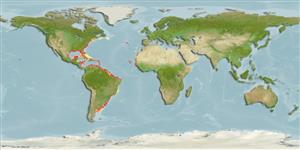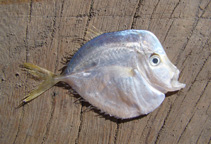Selene setapinnis (Mitchill, 1815)
Atlantic moonfish
Beobachtung melden im Fish Watcher
| Native range | All suitable habitat | Point map | Year 2050 |

|
| This map was computer-generated and has not yet been reviewed. |
| Selene setapinnis AquaMaps Data sources: GBIF OBIS |
Hochladen Photos und videos
Pictures | Sounds | Google Bild
Pictures | Sounds | Google Bild
Brazil country information
Common names:
Aracorana, Doutor, Fralda-rota
Occurrence: native
Salinity: marine
Abundance: | Ref:
Importance: | Ref:
Aquaculture: | Ref:
Regulations: | Ref:
Uses: no uses
Comments: Reported from Espírito Santo (Ref. 57756). Museum: off southern Brazil, MZUSP 78163 (Ref. 47377). Also Ref. 3277.
National Checklist:
Country Information: https://www.cia.gov/library/publications/resources/the-world-factbook/geos/br.html
National Fisheries Authority:
Occurrences: Occurrences Point map
Main Ref: Floeter, S.R., J.L. Gasparini, L.A. Rocha, C.E.L. Ferreira, C.A. Rangel and B.M. Feitoza, 2003
National Database:
Occurrence: native
Salinity: marine
Abundance: | Ref:
Importance: | Ref:
Aquaculture: | Ref:
Regulations: | Ref:
Uses: no uses
Comments: Reported from Espírito Santo (Ref. 57756). Museum: off southern Brazil, MZUSP 78163 (Ref. 47377). Also Ref. 3277.
National Checklist:
Country Information: https://www.cia.gov/library/publications/resources/the-world-factbook/geos/br.html
National Fisheries Authority:
Occurrences: Occurrences Point map
Main Ref: Floeter, S.R., J.L. Gasparini, L.A. Rocha, C.E.L. Ferreira, C.A. Rangel and B.M. Feitoza, 2003
National Database:
Common names from other countries
Klassifizierung / Names Namen | Synonyme | Catalog of Fishes(Gattung, Arten) | ITIS | CoL | WoRMS | Cloffa
> Carangiformes (Jacks) > Carangidae (Jacks and pompanos) > Caranginae
Etymology: Selene: Greek, selene = moon (Ref. 45335).
More on author: Mitchill.
Etymology: Selene: Greek, selene = moon (Ref. 45335).
More on author: Mitchill.
Environment: milieu / climate zone / depth range / distribution range Ökologie
seewasser; brackwasser benthopelagisch; tiefenbereich 0 - 55 m (Ref. 26912). Subtropical; 46°N - 45°S, 98°W - 16°W
Verbreitung Länder | FAO Gebiete | Ecosystems | Vorkommen | Point map | Einführungen | Faunafri
Western Atlantic: Nova Scotia, Canada through most of the West Indies; along coasts of Gulf of Mexico and South America (Ref. 26938) to Mar del Plata, Argentina. Absent from the Bahamas (Ref. 26938). Replaced by Selene dorsalis in the eastern Atlantic. These two species have not been adequately studied and may prove to be conspecific. Known to occur in Mauritania (Ref. 5377).
Length at first maturity / Size / Gewicht / Alter
Maturity: Lm 20.5 range ? - ? cm
Max length : 60.0 cm TL Männchen/unbestimmt; (Ref. 26340); common length : 25.0 cm TL Männchen/unbestimmt; (Ref. 5217); max. veröff. Gewicht: 4.6 kg (Ref. 26340)
Max length : 60.0 cm TL Männchen/unbestimmt; (Ref. 26340); common length : 25.0 cm TL Männchen/unbestimmt; (Ref. 5217); max. veröff. Gewicht: 4.6 kg (Ref. 26340)
Kurzbeschreibung Bestimmungsschlüssel | Morphologie | Morphometrie
Rückenflossenstacheln (insgesamt) : 9; Rückenflossenweichstrahlen (insgesamt) : 21; Afterflossenstacheln: 3; Afterflossenweichstrahlen: 17. Pelvic fin small (Ref. 13608). A very deep-bodied, short and strongly compressed fish. Facial profile nearly vertical and concave. Pelvic fin very short (Ref. 26938).
Adults usually found near the bottom from inshore waters to at least 54 m depth, but may form schools near the surface (Ref. 5217). Juveniles are found on muddy bottoms brackish estuaries and in coastal marine waters (Ref. 5217). Adults feed on small fishes and crustaceans. Good food fish and marketed fresh.
Life cycle and mating behavior Geschlechtsreife | Fortpflanzung | Ablaichen | Eier | Fecundity | Larven
Hauptreferenz
Upload your references | Referenzen | Koordinator : Smith-Vaniz, William F. | Partner
Cervigón, F., 1993. Los peces marinos de Venezuela. Volume 2. Fundación Científica Los Roques, Caracas,Venezuela. 497 p. (Ref. 9626)
IUCN Rote Liste Status (Ref. 130435: Version 2024-2)
nicht bedroht (LC) ; Date assessed: 21 August 2012
Nutzung durch Menschen
Fischereien: hoch kommerziell; Aquarium: Öffentliche Aquarien
FAO(Fischereien: production; publication : search) | FishSource | Sea Around Us
Mehr Information
Population dynamics
Growth parameters
Max. ages / sizes
Length-weight rel.
Length-length rel.
Längenhäufigkeiten
Mass conversion
Rekrutierung
Dichte
Growth parameters
Max. ages / sizes
Length-weight rel.
Length-length rel.
Längenhäufigkeiten
Mass conversion
Rekrutierung
Dichte
Life cycle
Fortpflanzung
Geschlechtsreife
Fecundity
Ablaichen
Spawning aggregations
Eier
Eientwicklung
Larven
Larven Pop.Dyn.
Fortpflanzung
Geschlechtsreife
Fecundity
Ablaichen
Spawning aggregations
Eier
Eientwicklung
Larven
Larven Pop.Dyn.
Anatomy
Kiemenoberfläche
Brain
Otolith
Kiemenoberfläche
Brain
Otolith
Physiology
Body composition
Nutrients
Oxygen consumption
Swimming type
Swimming speed
Visual pigments
Fish sound
Diseases & Parasites
Toxicity (LC50s)
Body composition
Nutrients
Oxygen consumption
Swimming type
Swimming speed
Visual pigments
Fish sound
Diseases & Parasites
Toxicity (LC50s)
Human related
Aquaculture systems
Aquakultur Profile
Zuchtlinien
Ciguatera cases
Stamps, coins, misc.
Aquaculture systems
Aquakultur Profile
Zuchtlinien
Ciguatera cases
Stamps, coins, misc.
Tools
E-book | Feldführer | Bestimmungsschlüssel | Längenhäufigkeits Tool | Lebensdaten Tool | Punkt Karte | Classification Tree
| Catch-MSY |
Zusatzinformationen
Download XML
Zusammenfassung | Point data | Namen | Photos
Internet Quellen
Aquatic Commons | BHL | Cloffa | Websites from users | FishWatcher Einträge suchen | CISTI | Catalog of Fishes(Gattung, Arten) | DiscoverLife | ECOTOX | Faunafri | Fishtrace | GenBank(Genom, nucleotide) | GloBI | GOBASE | | Google Books | Google Scholar | Google | IGFA World Record | MitoFish | Nationale Datenbanken | Otolith Atlas of Taiwan Fishes | Öffentliche Aquarien | PubMed | Reef Life Survey | Scirus | SeaLifeBase | Tree of Life | Wikipedia(Gehe zu, Suchen) | World Records Freshwater Fishing | Zoological Record
Estimates based on models
Preferred temperature (Ref. 115969): 12 - 27.9, mean 24.4 (based on 656 cells).
Phylogenetic diversity index (Ref. 82804): PD50 = 0.5039 [Uniqueness, from 0.5 = low to 2.0 = high].
Bayesian length-weight: a=0.01288 (0.01151 - 0.01441), b=2.96 (2.93 - 2.99), in cm Total Length, based on LWR estimates for this species (Ref. 93245).
Trophic level (Ref. 69278): 3.7 ±0.52 se; based on food items.
Widerstandsfähigkeit (Ref. 120179): mittel, Verdopplung der Population dauert 1,4 - 4,4 Jahre. (tmax=4.5; assuming tm=2-3).
Prior r = 0.54, 95% CL = 0.36 - 0.81, Based on 2 data-limited stock assessments.
Fishing Vulnerability (Ref. 59153): Low to moderate vulnerability (29 of 100).
Climate Vulnerability (Ref. 125649): Moderate vulnerability (36 of 100).





